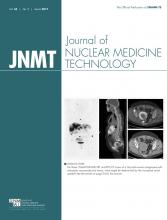Norman E. Bolus, MSPH, MPH, CNMT, FSNMMI-TS
The Merriam–Webster Dictionary defines manuscript simply as something written by hand or typed, with the origin of the word being the Latin manu scriptus and its first known use being 1597. On the basis of this definition, it is likely that you have written many manuscripts in your lifetime and not even realized it. For JNMT, we accept manuscripts in a number of categories, as described in the Information for Authors (http://tech.snmjournals.org/site/misc/JNMT Info for Authors.pdf). The main category is original laboratory or clinical investigations, which include imaging techniques, instrumentation, radiation safety, radiation biology, and other clinical or basic science topics. Brief communication manuscripts can include novel data of broad import to the field of nuclear medicine technology. Letters to the editor are also welcome, if you wish to comment on or clarify a published article. Invited articles, which I have openly requested over my tenure with JNMT, include perspectives, editorials, continuing education articles, teaching case studies, and special contributions such as chapter or international society reports. Continuing education articles can be on a variety of topics that I and the continuing education editor (currently Krystle Glasgow) feel are of interest to the readership. Teaching case studies were added as a category about 4 years ago and have introduced an element to JNMT that I think has been useful to readers. I would like to see more case studies involving instrumentation rather than just clinical issues, as I am sure there are lessons to be learned from quality control checks and equipment issues that would benefit the readership just as much as a traditional patient case study. There are many different types of manuscripts that can be submitted to the journal, and I would like to see more submissions.
Last year we had a decline in total submissions, for various reasons. I think one barrier to submissions is that many people feel intimidated by the peer review process. However, please consider it a necessary part of the process to ensure a good critique of your work. Please consider that your experience and knowledge in the field are something that others can gain from and will be something that the readership finds valuable. If you are a technologist, submitting teaching case studies may be the easiest route for publication, but if you work at a research institution consider writing up some of the unique research you are participating in.
So, why should you submit to JNMT? If you are a physician, researcher, or educator, you may need publications in a peer-reviewed journal as part of your goals for promotion and tenure. If you are a student, resident, or research trainee, submitted articles can add to your resume or curriculum vitae and perhaps make the difference for you when someone is considering hiring you. If nothing else, it encourages them to ask you questions about your publications and makes you unique to them, which can help in the interview process. There are many positive reasons to consider writing a manuscript, and I encourage you to take the time and effort to put pen or pencil to paper or type up a manuscript for consideration in JNMT.“If I waited for perfection, I would never write a word.”
—Margaret Atwood, novelist
In this issue of JNMT, in addition to reprinting a 2-part continuing education article that appeared previously in JNM, we have 2 unique continuing education articles. One, by Joseph Hung, discusses some potential ways to address shortage situations with 99Mo/99mTc, which I think is timely and interesting for our readership. The other, equally interesting, article, by Mary Beth Farrell, discusses compliance with gastric-emptying scintigraphy guidelines and is based on an analysis of the Intersocietal Accreditation Commission database. In addition, we have several articles on a variety of imaging topics such as the effects of gadolinium on PET/CT uptake in the dentate nucleus, an assessment of dual-tracer PET/CT with 68Ga-DOTATATE and 18F-FDG, and a comparison of different GFR calculation methods in patients with hepatic cirrhosis. We also have a case study looking at cirrhosis of the liver. Finally, we have added some information from the SNMMI website that we felt would be helpful to our readership.
For the Facebook question from JNMT for this issue, I simply ask, “What topics would you like to see in JNMT?” Please go to www.snmmi.org/facebook and add your comments.








